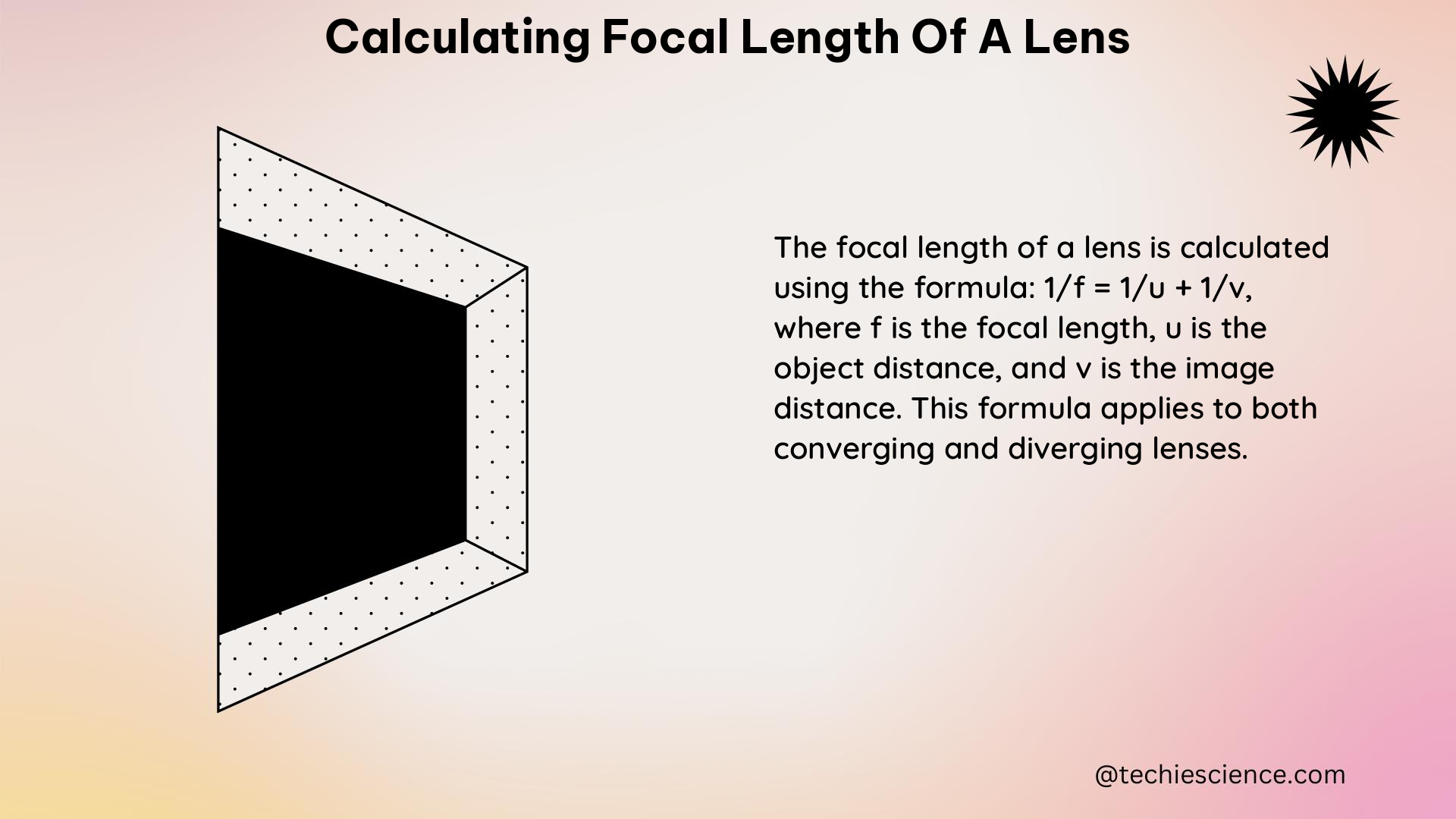The focal length of a lens is a crucial parameter in optics, as it determines the focusing power of the lens. It is defined as the distance between the lens and the point where the light rays converge or diverge to a point after passing through the lens. Accurately calculating the focal length of a lens is essential for various applications, such as photography, telescopes, and microscopes. In this comprehensive guide, we will explore the different methods and equations used to determine the focal length of a lens, along with detailed examples and numerical problems to help you master this concept.
Understanding the Lensmaker’s Equation
The lensmaker’s equation is a widely used method for calculating the focal length of a lens. This equation relates the focal length to the refractive index of the lens material, the radii of curvature of the lens surfaces, and the distance between the lens surfaces. The lensmaker’s equation is expressed as:
1/f = (n-1) x [1/R1 – 1/R2 + (n-1) x d/ (n x R1 x R2)]
Where:
– f is the focal length of the lens
– n is the refractive index of the lens material
– R1 and R2 are the radii of curvature of the lens surfaces
– d is the distance between the lens surfaces
Example 1: Calculating Focal Length Using the Lensmaker’s Equation
Let’s consider a lens with the following properties:
– Refractive index (n) = 1.5
– Outer radius of curvature (R1) = 6.95 cm
– Inner radius of curvature (R2) = 7 cm
– Distance between lens surfaces (d) = 0 cm (thin lens)
Plugging these values into the lensmaker’s equation, we get:
1/f = (1.5-1) x [1/6.95 – 1/7 + (1.5-1) x 0/ (1.5 x 6.95 x 7)]
1/f = 0.5 x [1/6.95 – 1/7]
1/f = 0.0282 cm^-1
f = 1/0.0282 cm^-1 = 35.4 cm
Therefore, the focal length of the lens is 35.4 cm.
Utilizing the Thin Lens Equation

Another method for calculating the focal length of a lens is the thin lens equation, which relates the object distance (do), the image distance (di), and the focal length (f) of a thin lens. The thin lens equation is expressed as:
1/f = 1/do + 1/di
Example 2: Calculating Focal Length Using the Thin Lens Equation
Suppose an object is placed 20 cm in front of a lens, and the image is formed 10 cm behind the lens. We can use the thin lens equation to calculate the focal length of the lens.
Plugging the values into the equation:
1/f = 1/20 + 1/10
1/f = 0.1 + 0.1
1/f = 0.2 cm^-1
f = 1/0.2 cm^-1 = 5 cm
Therefore, the focal length of the lens is 5 cm.
Determining Focal Length from Angle of View
The focal length of a camera lens can also be calculated by measuring the angle of view and using the following formula:
Focal length = (Sensor size / 2) x (Cotangent of half the angle of view)
Example 3: Calculating Focal Length from Angle of View
Suppose a camera lens has an angle of view of 45 degrees and a sensor size of 24 mm x 36 mm. We can use the formula to calculate the focal length of the lens.
Focal length = (24 mm / 2) x (Cotangent of 45/2 degrees)
Focal length = 12 mm x (Cotangent of 22.5 degrees)
Focal length = 12 mm x 2.414
Focal length = 43.3 mm
Therefore, the focal length of the lens is 43.3 mm.
Numerical Problems
-
A lens has a refractive index of 1.6, an outer radius of curvature of 8 cm, and an inner radius of curvature of 10 cm. Assuming the lens is thin, calculate the focal length of the lens.
-
An object is placed 30 cm in front of a lens, and the image is formed 20 cm behind the lens. Calculate the focal length of the lens.
-
A camera lens has an angle of view of 60 degrees and a sensor size of 36 mm x 24 mm. Calculate the focal length of the lens.
-
A biconvex lens has a refractive index of 1.55 and radii of curvature of 20 cm and 25 cm. If the distance between the lens surfaces is 2 cm, calculate the focal length of the lens.
-
A diverging lens has a refractive index of 1.4 and radii of curvature of -10 cm and -15 cm. Calculate the focal length of the lens.
Conclusion
In this comprehensive guide, we have explored the various methods and equations used to calculate the focal length of a lens, including the lensmaker’s equation, the thin lens equation, and the angle of view method. We have provided detailed examples and numerical problems to help you understand and apply these concepts in real-world scenarios. By mastering the techniques presented in this guide, you will be well-equipped to determine the focal length of any lens, which is a crucial skill in the field of optics and photography.
References
- How to Calculate the Focal Length of a Lens Given Index of Refraction, Study.com, https://study.com/skill/learn/how-to-calculate-the-focal-length-of-a-lens-given-index-of-refraction-explanation.html
- How To Calculate A Lens’ Focal Length : Slightly Simplified, Light and Matter, https://www.lightandmatter.org/2015/tech-photography-articles/how-to-calculate-a-lens-focal-length-slightly-simplified/
- The Mathematics of Lenses, The Physics Classroom, https://www.physicsclassroom.com/class/refrn/Lesson-5/The-Mathematics-of-Lenses
- Focal Length, RP Photonics, https://www.rp-photonics.com/focal_length.html
- Modeling with the “Thin Lens” Equation, Arbor Scientific, https://www.arborsci.com/blogs/cool/modeling-the-thin-lens-equation

The lambdageeks.com Core SME Team is a group of experienced subject matter experts from diverse scientific and technical fields including Physics, Chemistry, Technology,Electronics & Electrical Engineering, Automotive, Mechanical Engineering. Our team collaborates to create high-quality, well-researched articles on a wide range of science and technology topics for the lambdageeks.com website.
All Our Senior SME are having more than 7 Years of experience in the respective fields . They are either Working Industry Professionals or assocaited With different Universities. Refer Our Authors Page to get to know About our Core SMEs.